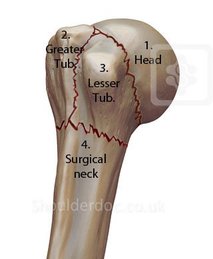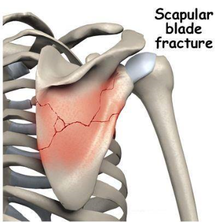Fractures
Shoulder fractures can be located in a number of different places; the clavicle, the upper arm and the shoulder blade.
Fracture of the Clavicle
The clavicle, or collarbone, is the connecting bone between the arm and body and you can feel it lying along the front of the shoulder. A collarbone is a common fracture, usually in the middle of the bone, and are often caused by a fall or a blow to the shoulder. It is commonly seen in contact sports such as rugby and potentially high impact sports such as horse riding. Patients tend to have problems raising their arm and this can be a very a painful injury. You may see a swelling, bump or bruising where it has been broken. At your consultation at Advance Physiotherapy, we will examine the shoulder and then usually perform an X-ray to confirm the diagnosis. A CT scan can also be ordered.
The clavicle, or collarbone, is the connecting bone between the arm and body and you can feel it lying along the front of the shoulder. A collarbone is a common fracture, usually in the middle of the bone, and are often caused by a fall or a blow to the shoulder. It is commonly seen in contact sports such as rugby and potentially high impact sports such as horse riding. Patients tend to have problems raising their arm and this can be a very a painful injury. You may see a swelling, bump or bruising where it has been broken. At your consultation at Advance Physiotherapy, we will examine the shoulder and then usually perform an X-ray to confirm the diagnosis. A CT scan can also be ordered.
A collarbone should heal well if rested and supported in a sling, followed by physiotherapy. However, if the damage is more extensive and the bones have become displaced, you may require surgery to realign the collarbone.
During your consultation at Advance Physiotherapy, we will advise you on the most appropriate treatment for you and monitor your recovery to ensure a return to full mobility.
|
Fracture of the Upper Arm
The top of the humerus or upper arm bone forms the ball part of the shoulder joint. Fractures here can be caused by a collision or breaking a fall with a straightened arm and often occur in older patients suffering from osteoporosis. Patients typically present with pain and limited movement of the shoulder and there is usually bruising and swelling. Your range of movement and amount of discomfort will be assessed and then your Advance Physiotherapy therapist will order investigative tests. Most fractures will heal without surgery and you will be prescribed anti-inflammatories and advised to wear a sling or a clavicle brace to support the shoulder until you can begin gentle stretching exercises. However, bone displacement may require surgery to realign the bones or they will heal out of alignment, potentially causing further problems in the future. The surgical option does mean an extensive recovery period, so the patient must be committed to following a lengthy physiotherapy programme afterwards and be realistic about what the procedure entails. |
|
Fracture of the Shoulder Blade
The shoulder blade, technically known as the scapula, is the bony plate that protects the chest. It is surrounded by muscle so is rarely fractured. Typically, it requires a high-impact injury, although it is possible to develop stress fractures over time. Often this fracture will resolve itself with rest followed by physiotherapy an orthopaedic opinion is usually required to determine whether surgery is necessary. If you have had a fracture of the clavicle, humerus or scapula and require rehabilitation, please arrange a consultation with Advance Physiotherapy. |

